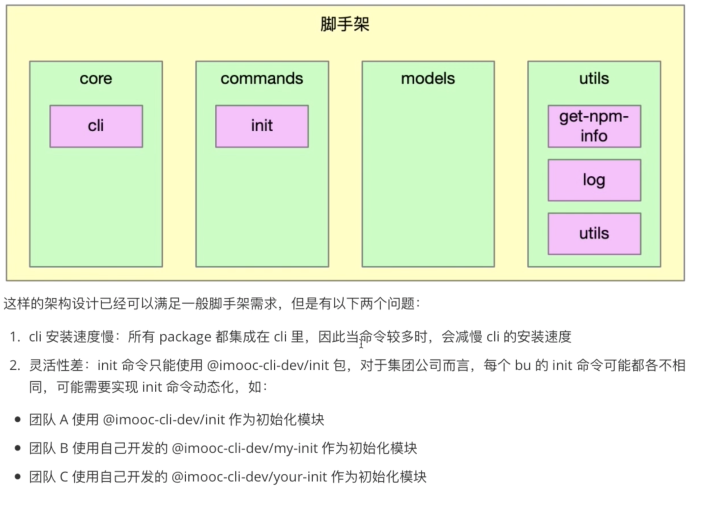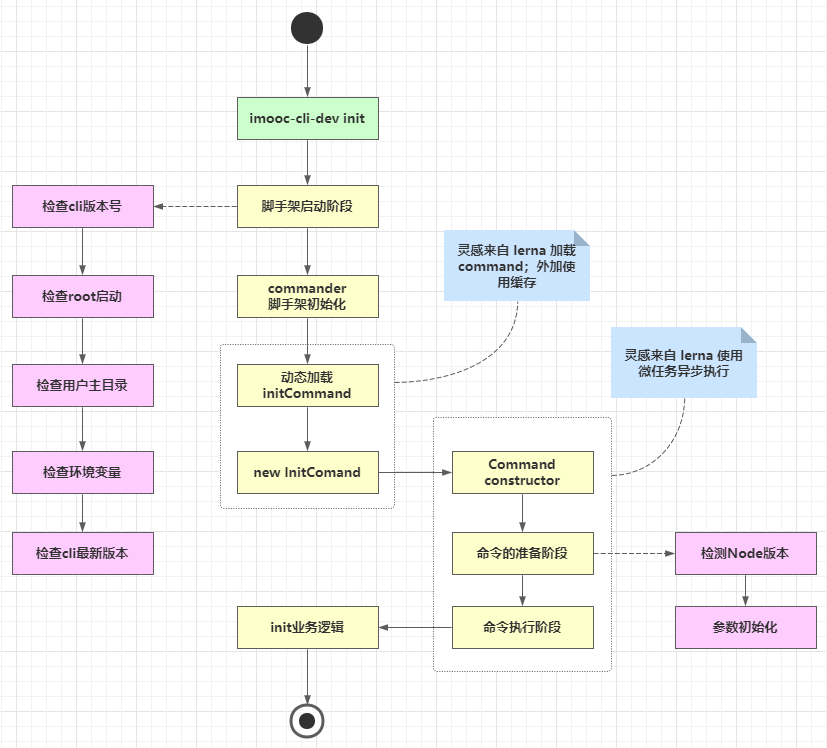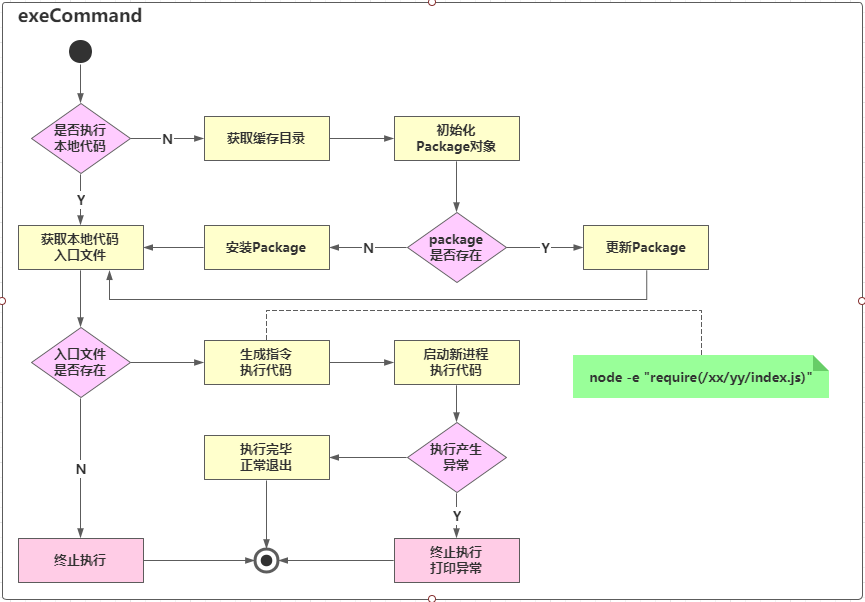笔记
第一章:本周导学
1-1 本周整体内容介绍和学习方法
标题
- 基于Commander完成脚手架命令注册和命令执行过程开发
收获
- 如何设计高性能脚手架
- Node多线程开发
- javascript面向对象编程的实战技巧
内容
- 图解高性能脚手架架构设计方法
- 封装通用的Package和Command类
- 基于缓存 + Node 多进程 实现动态命令加载和执行
- 将业务逻辑和脚手架逻辑彻底解耦
加餐
Node多进程开发进阶--child_process源码解析
- 深入Node源码看清spawn/exec/execFile/fork的本质区别,彻底搞懂Node多进程原理。
第二章:imooc-cli脚手架命令注册
2-1 imooc-cli脚手架初始化+全局参数注册
(本节有代码编写) 本节的主要内容为使用commander这个库在全局添加注册命令
- cd core/cli
- npm i -S commander
// core/cli/lib/index 添加全局注册命令方法
//命令注册
function registerCommand(){
program
.name(Object.keys(pkg.bin)[0])
.usage('<command> [options]')
.version(pkg.version)
.option('-d, --debug', '是否开启调试模式', false);
// 开启debug模式
program.on('option:debug',function(){
if(program.opts().debug){
process.env.LOG_LEVEL='verbose'
}else{
process.env.LOG_LEVEL='info'
}
log.level = process.env.LOG_LEVEL
})
// 对未知命令监听
program.on('command:*',function(obj){
const availableCommands = program.commands.map(cmd => cmd.name())
console.log(colors.red('未知的命令:'+obj[0]))
if(availableCommands.length > 0){
console.log(colors.red('可用命令为:'+availableCommands.join(',')))
}
})
program.parse(program.argv)
if(program.args && program.args.length < 1) {
program.outputHelp();
console.log()
}
}
2-2 imooc-cli脚手架命令注册
(本节有代码编写)
本节的主要内容为添加第一个comman操作:'init',并在commands文件夹下创建新的init包
// core/cli/lib/index
......
const init = require('@cloudscope-cli/init')
......
program
.command('init [projectName]')
.option('-f,--force','是否强制更新项目')
.action(init)
......
第三章:高性能脚手架架构设计和缓存结构设计
3-1 当前imooc-cli脚手架架构痛点分析
当前的代码架构如图:

3-2 高性能脚手架架构设计
对以上架构(之前代码编写)的主要优化点有以下三个方面
- 将init命令做成了一个动态加载的形式
- 动态加载的脚手架通过缓存形式进行存储:执行哪个命令下载哪个命令
- 动态加载的时候,通过node多进程进行执行:深挖cpu性能

3-3 脚手架命令动态加载功能架构设计

上图架构是动态加载initComand开始的
本节简单讲述了两点:
- require加载文件的用法:
- require('/xxx/yyy/index.js') ---- 加载绝对路径
- require('./index.js')----加载相对路径
- require('fs') ---- 加载内置模块
- require('npmlog') ---- 加载第三方包
- node执行模块两种方式
- node 执行文件: node core/cli/bin/index.js
- node -e '字符串':node -e "require(./core/cli/bin/index.js)"
4-1 脚手架命令本地调试功能支持
通过前面画图了解,我们要实现的第一步是initCommand的动态命令加载,即3-3章节所示图。 是否执行本地代码,我们通过一个属性来进行标识:targetPath
//core/cli/lib/index.js
program.
.option('-tp, --targetPath <targetPath>','是否指定本地调试文件路径','')
//指定targetPath
program.on('option:targetPath',function(){
process.env.CLI_TARGET_PATH = program.opts().targetPath
})
// commands/init/lib/index.js
'use strict';
function init(projectName,options,command) {
console.log('init',projectName,command.opts().force,process.env.CLI_TARGET_PATH)
}
module.exports = init;
本节需要注意的一点是如果commander版本低于7.0.0,那么 program.action()中传入的参数为两个。 7.0.0版本以上的传入的参数为三个(name.options,cmd)
另外,访问targetPath这个参数的时候,需要program.opts().targetPath访问。
4-2 动态执行库exec模块创建
(本节有代码编写)
core下新建包文件: lerna create @cloudscope-cli/exec core/ 然后在core/cli/lib/index.js文件中将exec包引入,将action(init)此处改为action(exec)
4-3 创建npm模块通用类Package
<br />(本节有代码编写)
首先讲解了exec模块逻辑
- targetPath -> modulePath
- modulePath -> Package(npm模块)
- Package.getRootFile(获取入口文件)
- Package.update / Package.install
<br />代码实现:
- 在model文件下创建新的模块Package:lerna create @cloudscope-cli/package
- 在core/exec/lib/index.js文件中引入:const Package = require('@cloudscope-cli/package')
4-4 Package类的属性、方法定义及构造函数逻辑开发
(本节有代码编写)
本节主要有三处代码讲解
- core/exec中创建一个Package对象
- model/package中Package类的构造方法
- utils/utils中添加isObject方法:判断一个属性是否为对象
代码分别如下:
// core/exec/lib/index.js
'use strict';
const Package = require('@cloudscope-cli/package')
const log = require('@cloudscope-cli/log')
const SETTINGS = {
init: '@cloudscope-cli/init'
}
function exec() {
// 1. targetPath -> modulePath
// 2. modulePath -> Package(npm模块)
// 3. Package.getRootFile(获取入口文件)
// 4. Package.update / Package.install'
let targetPath = process.env.CLI_TARGET_PATH
const homePath = process.env.CLI_HOME_PATH
let storeDir ='';
let pkg;
log.verbose('targetPath', targetPath);
log.verbose('homePath', homePath);
const cmdObj = arguments[arguments.length - 1];
const cmdName = cmdObj.name();
const packageName = SETTINGS[cmdName];
const packageVersion = 'latest';
pkg = new Package({
targetPath,
storeDir,
packageName,
packageVersion
})
console.log(pkg)
}
module.exports = exec;
//models/package/lib/index.js
'use strict';
const { isObject } = require('@liugezhou-cli-dev/utils');
class Package {
constructor(options){
if( !options){
throw new Error('Package类的options参数不能为空!')
}
if( !isObject(options) ){
throw new Error('Package类的options参数必须为对象!')
}
// package路径
this.targetPath = options.targetPath
// package的存储路径
this.storeDir = options.storeDir
// package的name
this.packageName = options.packageName
// package的version
this.packageVersion = options.packageVersion;
}
// 判断当前Package是否存在
exists(){}
// 安装Package
install(){}
//更新Package
update(){}
//获取入口文件路径
getRootFilePath(){}
}
module.exports = Package;
//utils/utils/lib/index.js
'use strict'
function isObject(obj){
return Object.prototype.toString.call(obj).slice(8,-1) === 'Object'
}
module.exports = {
isObject
}
4-5 Package类获取入口文件路径功能开发(pkg-dir应用+解决不同操作系统路径兼容问题)
(本节有代码编写)<br />本节主要实现models/package/lib/index.js中获取入口文件路径的方法实现getRootfile()<br />
思路:
- 获取package.json的所在目录--通过安装pkg-dir库
- 读取package.json
- 寻找main/lib
- 路径的兼容macOS/windows --新建包:utils/format-path,且新建路径兼容方法
核心代码为:
//core/exec/lib/index.js
…………
// 1. 获取package.json所在目录
const dir = pkgDir(targetPath);
if (dir) {
// 2. 读取package.json
const pkgFile = require(path.resolve(dir, 'package.json'));
// 3. 寻找main/lib
if (pkgFile && pkgFile.main) {
// 4. 路径的兼容(macOS/windows)
return formatPath(path.resolve(dir, pkgFile.main));
}
}
return null;
…………
'use strict';
const path = require('path')
function formatPath(p) {
const sep = path.sep;
if(p && typeof p === 'string'){
if(sep !=='/'){
return p.replace(/\\/g,'/')
}
}
return p
}
module.exports = formatPath;
4-6 利用npminstall库安装npm模块
<br />(本节有代码编写)
本节实现的内容为exec中的install方法,通过npminstall这个库。 使用之前现在测试项目下使用之:测试代码。
const npminstall = require('npminstall')
const path = require('path')
const userHome = require('user-home')
npminstall({
root: path.resolve(userHome,'.cli-test'), //模块路径
storeDir: path.resolve(userHome,'.cli-test','node_modules') ,
registry:'https://registry.npmjs.org',
pkgs:[
{name:'foo',version:'~1.0.0'}
]
})
- 首先,我们的项目在开发过程中可能会有错误,有的需要去看执行栈,有的不需要,因此我们在core/cli/lib/index中的core方法中,catch语句中加入如下代码(debug模式下显示执行栈错误)
if(program.opts().debug){
console.log(e)
}
2.在core/exec/lib/index.js文件中,我们修改代码如下(主要加入了如果不存在targetPath的逻辑梳理):
'use strict';
const path = require('path') //新添加
const Package = require('@cloudscope-cli/package')
const log = require('@cloudscope-cli/log')
const SETTINGS = { //新添加
init: '@imooc-cli/init'
}
const CATCH_DIR = 'dependencies' //新添加
async function exec() {
let targetPath = process.env.CLI_TARGET_PATH
const homePath = process.env.CLI_HOME_PATH
let storeDir ='';
let pkg;
log.verbose('targetPath', targetPath);
log.verbose('homePath', homePath);
const cmdObj = arguments[arguments.length - 1];
const cmdName = cmdObj.name();
const packageName = SETTINGS[cmdName];
const packageVersion = 'latest';
if(!targetPath){
//生成缓存路径
targetPath = path.resolve(homePath,CATCH_DIR); //新添加
storeDir = path.resolve(targetPath,'node_modules') //新添加
log.verbose('targetPath:',targetPath) //新添加
log.verbose('storeDir:',storeDir) //新添加
pkg = new Package({ //新添加
targetPath,
storeDir,
packageName,
packageVersion
});
if(await pkg.exists()){ //新添加
// 更新package
log.verbose('更新package')
await pkg.update();
}else{
// 安装package
await pkg.install();
}
}else{
pkg = new Package({
targetPath,
packageName,
packageVersion
})
const rootFile = pkg.getRootFilePath();
if(rootFile){ //新添加
require(rootFile).apply(null,arguments);
}
}
}
module.exports = exec;
- model/package包中文件主要加入了安装package这个方法,使用了npminstall这个库。
//models/package/lib/ibdex.js
async install(){
await this.prepare()
return npminstall({
root: this.targetPath,
storeDir: this.storeDir,
registry:getDefaultRegistry(),
pkg:{
name:this.packageName,
version:this.packageVersion
}
})
}
4-7 Package类判断模块是否存在方法开发
本节的主要内容是实现package/lib/index.js中的exists方法,代码实现如下:
…………
// package的缓存目录前缀
this.cacheFilePathPrefix = this.packageName.replace('/', '_')
…………
get cacheFilePath() {
return path.resolve(this.storeDir,`_${this.cacheFilePathPrefix}@${this.packageVersion}@${this.packageName}`)
}
async prepare(){
if(this.storeDir && !pathExists(this.storeDir)){
fse.mkdirpSync(this.storeDir)
}
if(this.packageVersion === 'latest'){
this.packageVersion = await getNpmLatestVersion(this.packageName);
}
}
async exists(){
if(this.storeDir){
await this.prepare()
return pathExists(this.cacheFilePath);
}else{
return pathExists(this.targetPath);
}
}
4-8 Package类更新模块逻辑开发
<br />(本节有代码编写)
本节内容主要为如果Package包有升级,那么需要去更新,主要实现代码为:
// models/package/lib/index.js
…………
getSpecificCacheFilePath(packageVersion){
return path.resolve(this.storeDir,`_${this.cacheFilePathPrefix}@${packageVersion}@${this.packageName}`)
}
//更新Package
async update(){
//获取最新的npm模块版本号
const latestPackageVersion = await getNpmLatestVersion(this.packageName);
// 查询最新版本号对应的路径是否存在
const latestFilePath = this.getSpecificCacheFilePath(latestPackageVersion)
// 如果不存在,则直接安装最新版本
if(!pathExists(latestFilePath)){
await npminstall({
root:this.targetPath,
storeDir:this.storeDir,
registry:getDefaultRegistry(),
pkgs:[{
name:this.packageName,
version:latestPackageVersion
}
]
})
this.packageVersion = latestPackageVersion
}else{
this.packageVersion = latestPackageVersion
}
return latestFilePath;
}
4-9 Package类获取缓存模块入口文件功能改造
//获取入口文件路径
getRootFilePath(){
function _getRootFile(targetPath) {
// 1. 获取package.json所在目录
const dir = pkgDir(targetPath);
if (dir) {
// 2. 读取package.json
const pkgFile = require(path.resolve(dir, 'package.json'));
// 3. 寻找main/lib
if (pkgFile && pkgFile.main) {
// 4. 路径的兼容(macOS/windows)
return formatPath(path.resolve(dir, pkgFile.main));
}
}
return null;
}
if (this.storeDir) {
return _getRootFile(this.cacheFilePath);
} else {
return _getRootFile(this.targetPath);
}
}